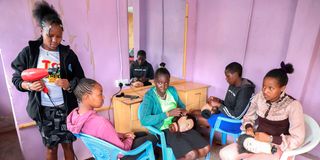'We had no money for anti-FGM work’: The cost of gender equality underfunding

Girls participate in skills training sessions at the Mission with Vision Girls' Rescue Centre in Nairobi County on September 26, 2024. Kenya's gender equality programs survive on less than one percent of the national budget.
What you need to know:
- Gender offices in Kenya operate on less than one percent of the national budget.
- Anti-FGM officials in Narok, for example, receive only Sh50,000 quarterly for operations.
- Public institutions spent just 0.08 percent on gender equality programs in 2022/2023.
In 2022, a State Department of Gender official deployed in Narok County lamented the limited budget constraining their anti-Female Genital Mutilation (FGM) interventions.
This was the climax year during which the government had promised to end FGM.
She noted that since her deployment in 2020, her office had received between Sh100,000 and Sh150,000 annually from the national government, funds she said were insufficient to sustain their fieldwork.
“The little amount we get, like Sh50,000 every quarter, is just used to buy stationery and pay for minor office expenses. Narok is a vast county, and with such limited funds, we cannot move to the field to collect real-time evidence that would nail FGM culprits,” she told a Nation.Africa reporter during an interview.
The officer’s frustrations with service delivery reflect the country’s persistent underfunding of gender mainstreaming.
An analysis of budgetary allocations shows that allocations have consistently remained below one per cent.
Publish What You Fund, a global organisation campaigning for aid transparency, tracked gender financing in Kenya for three consecutive financial years starting in 2018/19.
Despite the total annual budget expanding, gender equality allocations have remained static at 0.3 per cent.
For instance, in 2019/20, out of a $25 billion budget, the national government allocated only $72 million, an increase of just $1 million from the previous fiscal year. Kenya’s 2018/19 total budget was also $25 billion.
In 2020/21, the allocation remained at a similar level, with $81 million out of an annual budget of $31 billion, equivalent to a mere 0.3 per cent.
Last year, the National Gender and Equality Commission released a report on the Status of Gender Equality and Inclusion in the Public Sector, which showed no significant increase in allocations.
The report indicated that in 2022/2023, public sector institutions allocated approximately Sh1.9 billion, equivalent to 0.08 per cent of the total public sector budget.
The gender equality watchdog recommended that public sector institutions allocate at least 1.5 per cent of their total annual budgets to gender mainstreaming.
In an earlier interview, gender and development expert Chryspin Afifu said that for Kenya to achieve sustainable development through gender-responsive budgeting, the systems, processes, and institutions involved in determining allocations must be transformed.
“You cannot expect a government that is not gender-responsive to allocate resources in a gender-responsive manner,” he said.
He added that Kenya has failed by assuming it has addressed women’s needs through affirmative programmes like Access to Government Procurement Opportunities (AGPO).
“For instance, studies have shown that the 30 percent procurement opportunities reserved for women and youth under AGPO do not necessarily go to women. Behind the companies registered in the name of a woman are men, yet the government assumes women have benefitted.”
He expressed hope that with progressive programming of budget sectors through a gender lens, Kenya would finally reap the benefits of gender-responsive budgeting.


